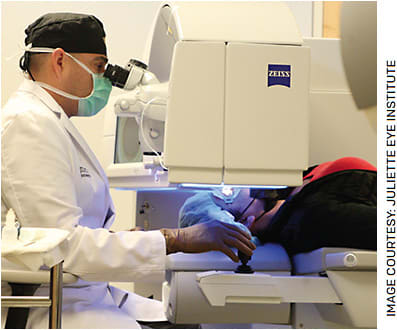Follow these tips for creating a successful private practice.
When starting a new practice, several steps are required to be successful. Without taking these steps, your practice may run into challenges and pitfalls. In this article, I will share the steps my practice, Juliette Eye Institute in Albuquerque, N.M., put into place that has helped our business grow.
KNOW WHEN TO SEEK HELP
When starting a practice, take stock of what you are best at and where you need the most help. You might be great with operations and marketing, but you may need accounting and legal help. Hire the appropriate people to help you in those areas.
DRAFT A BUSINESS PLAN
Draft a business plan that highlights your mission or your “why.” Simply opening a business to create autonomy for yourself is not enough justification to open the business. A business plan will outline your core competencies, but it has to be commensurate with generating enough profit to sustain a business. You have to be true to your mission statement while also wearing your business hat that will generate enough revenue to cover your expenses.

STAY LEAN
Initially upon opening your business, stay lean with expenses and invest in the most critical technologies that will help boost growth (ie, pay the bills). Methodically introduce layers of technology and techniques that build on each other while growing revenues. When I first opened my practice in the middle of the COVID pandemic, I started with LASIK because I knew it was a self-pay service and would serve to help pay the bills. I was overly aggressive and tried to start cataract surgery at the same time. My staff wasn’t ready to maintain this higher volume while learning the technologies from the ORA system (Alcon), new Argos biometer (Alcon) and laser cataract surgery. I learned that many processes need to be taken into consideration when implementing newer technologies to a practice. To ensure that staff was up to speed on the new technology, we implemented additional training days to educate them — training is essential for the long-term benefit.
FOCUS ON ONE MAJOR CORE COMPETENCY
Opening a new practice is just that: new. Everything is new from billing, coding, technologies, staff, building, rent, bills, etc. Focus on one major core competency that would generate the most amount of revenue and incur the lowest expenses, and add accordingly once the staff is fully trained and operational.
TAKE AMPLE TIME TO TRAIN YOUR STAFF
Allow enough time for the team to learn the newer technologies, patient flow and educational pieces, reimbursement, etc. If the surgeon is learning a new technique, consider shadowing one or two surgeons in another practice to learn more, as well as learning processes such as technical tips, patient flow and reimbursement ideas. Also, consider bringing in outside training staff to ensure that your surgery day runs smoothly. For example, iOR Partners sent in highly trained instructors to help educate our staff in the operating room — they provided us with a registered nurse and two circulators to train each of our staff members.
CONCLUSION
When starting a practice, know when to seek help, draft a business plan, stay lean, focus on one major core competency and make sure staff is trained on technology. These are the keys to helping you to create a successful practice. OM
To share your story for an upcoming Lessons Learned, email julie.greenbaum@pentavisionmedia.com









